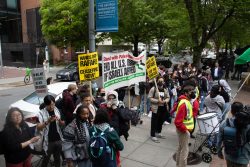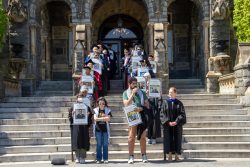The new resident at 1600 Pennsylvania Avenue, NW is not the most popular man in town. He received under 50 percent of the votes cast in November’s election, and signs questioning the legitimacy of his presidency are still on display throughout the city. But, partisan bickering aside, most people in the District have come to accept that he is the President and the head of our country. The jury is still out, though, on whether he will be a friend to Washington, D.C.
Most readers of this paper will only remember the relationship the city had with the Clinton administration. Clinton, a vocal proponent of the District, was hugely popular, and supported the District, nominally at least, at every step of the way during his presidency. Those whose memories stretch back a little further, though, tell tales of a 12-year Dark Age under the Reagan-Bush administrations, when the city was virtually ignored by its most visible resident.
The question then presents itself: Will W. be more like his role model, his father, or more like the man he patterned his politics after, Clinton?
We’ve already seen him sidestep the issues, seemingly avoiding a conflict with the political powers-that-be. One can only wonder, though?what constituency is he afraid of pissing off? The issue here is that the District has no voice. At best, we have proxy votes, representatives of the Washington suburbs who are concerned with the District. But Bush has taken the equivocal route even when not necessary.
One issue that Bush has taken a stand on was part of his “platform” on city issues. He pledged to re-open the stretch of Pennsylvania Avenue in front of the White House, between 15th and 17th Streets, which was closed during the Clinton years for security reasons. Many District residents support re-opening the block, if only to alleviate traffic downtown. The only constituency, seemingly, that would be pissed off in this case is the group of roller hockey players that have adopted the street as their home court.
This issue has been complicated as of late by the renewed threat of violence against the President, which hit the front pages last month when a would-be assassin was captured outside of the White House gates. Proponents of keeping the block closed argue that such episodes of violence around the White House prove the threat to the President is real, and the street needs to remain closed. Those in favor of opening the block to traffic point out that this man was captured, and that the Secret Service has established a comprehensive security plan.
All that being said, I remain unconvinced that re-opening Pennsylvania Avenue to traffic is as fundamental a right as the proponents of re-opening are arguing. By closing off the block, the city has created an oasis in the middle of the nation’s capital, stretching from Lafayette Park in the north all the way south to the Ellipse. The atmosphere now on the stretch of Pennsylvania Avenue gives the sense that it is the nation’s block: protesters line in front of the White House, bikers and joggers move past and the occasional street hockey game is played. Pennsylvania Avenue is a major artery through the city, connecting Capitol Hill to Georgetown. But diverting traffic around this two-block stretch is worth it, considering the benefits. And while this position will be unpopular with many of the District’s residents, Bush is not exactly popular here to begin with. He should announce that Pennsylvania Avenue will remain closed indefinitely and turn it into a national park. It will make up for the ones he’s drilling through in Alaska.




